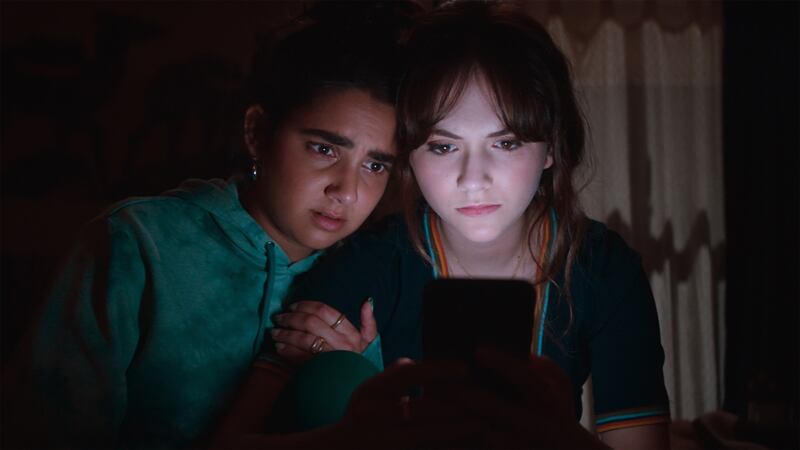A tale like the one told in “Cat Person,” Kristen Roupenian’s viral New Yorker short story, no longer feels remarkable. Its plainspoken account of a college girl’s ill-fated relationship with a much older man is one that people—women, really—now talk about all the time. I’ve dated a weirdo who came on too strong! I’ve dated a terrible kisser! I’ve dated a guy who lashed out when I tried to end things!
But in 2017, “Cat Person” felt like a weight lifted off women’s shoulders. Finally, someone had put to words the experience we’d all had but never felt comfortable sharing: that of feeling obligated to placate the whims of an emotionally volatile partner. The story’s final word put a searing punctuation mark on the message: “Whore.”
The new film adaptation of Cat Person, however, seems to realize that the story’s gutting ending and overall sense of unease may not hit the same way it once did. (It doesn’t help that we now know the backstory of how “Cat Person” came to be, thanks to a shocking Slate essay that details how Roupenian came to liberally borrow from a young woman’s lived experience.) The film’s way of challenging today’s viewer to self-reflect on heteroromantic power dynamics is by … making Cat Person into a trashy, absurd, bizarre, unbelievably terrible thriller. Rarely do I text a friend while watching a film to say how much it sucks before it’s even over—and I can count the number of friends I texted during Cat Person on both hands.
Spoilers, obviously, follow.
While “Cat Person” the story ends with 20-year-old college girl Margot receiving a surprisingly cruel text from the much older man she recently broke things off with, Cat Person the movie finds such an open ending insufficient. Instead, sophomore Margot (a poorly served Emilia Jones) decides she’s not going to sit and take 33-year-old Robert’s text shitstorm.
Following that drunken text tirade—inspired by Margot’s failure to avoid running into Robert during drinks with friends, a scene bizarrely played for laughs—Margot’s convinced that the classic Nice Guy (Succession’s Nicholas Braun, suitably awk) is now stalking her. She sees him waiting outside of the movie theater where she works, but the cops say they can’t do anything unless he actually confronts her. So Margot decides to confront him instead, buying mace and a tracker to stick on his car.
Despite her best friend Taylor’s (Geraldine Viswanathan) insistence not to, Margot heads out alone to Robert’s house. The plan is to quickly bug his car and dip, which is obviously not going to work since there’s at least 20 minutes of the movie left. Robert and his mean dog, whom Margot first saw following her home in the film’s opening, discover her in the garage and try to wrest control of the situation.

Here’s what happens next: Margot sprays the mace in her own eyes and busts her face open. She comes to, now inside of Robert’s sinister living room. Robert yells at Margot for being fake during their relationship, which consisted of two dates and a ton of text messages that he read and re-read over and over. In case you didn’t know that the film wanted you to believe Nice Guys are Not Nice Guys, now you know!
But then Margot sneakily manages to call 911 when Robert goes to finally help her clean her stinging eyes, and all hell breaks loose. I could not believe what was happening: Margot and Robert start fighting in the kitchen, screaming at each other, with Margot trying to escape and Robert refusing to let her. He has to figure out how to deal with this situation that she’s put him in, he says, that will definitely ruin both of their lives.
Their fight takes them to the basement, where Margot somehow accidentally starts a fire in all the commotion. Robert drags her into his very convenient crawl space underneath the basement floor, saving both of their lives as the rest of his house dramatically burns down around them.
After all that drama, Robert quits his job and moves away—what with his house burning down and a bleeding girl with mace in her eyes found next to him at the scene. Margot continues on with her life, and the film teases that she may not have learned her lesson from getting entangled with a strange older man.
Reader, I lost it.
To recap: A short story that incisively unpacked the roles men and women play in relationships was adapted into a psycho-thriller in which said man and woman barely escape with their lives in a house fire they started in a bloody brawl. It is ridiculous on its face, absent of the source material’s context. Women don’t need a warning that’s this over the top to play it safe around strangers, nor do we need the situation of potential domestic abuse blown up to such a ludicrous degree. By diving headfirst into feverish chaos, Cat Person sacrifices any of the intimate intention it should impart.
But that’s pretty clear from the get-go, anyway, what with the film’s habit of indulging in stylized sequences of hypothetical situations Margot could get herself into with a man she barely knows: him strangling her, him assaulting her, him murdering her in a closet, and on and on. I’d be hard-pressed to find a person who would find comedy in the pathetic ways these moments are envisioned here, but comedy is what Cat Person keeps chasing.
Perhaps it’s because the truth of the short story—that women only have so much control in a patriarchal society that empowers men to determine a relationship construct—is not as cinematically engaging as panicking over whether a woman will literally make it out of a breakup alive.
The best reminder the movie can give is that you should block his number the second he says “whore”—and you should turn Cat Person off after that moment, too.






